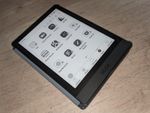Onyx BOOX Poke3
★★★★☆
I’ve been using the Poke3 as my main ebook reader for a couple of years now. It’s the same 6-7-inch form factor as the Kindle Paperwhite or the Kobo Clara, which makes it easy to carry around whether you’re reading on the go, in bed, or anywhere in between. It’s an e-ink display, which means its battery lasts longer and you can read it easily in bright sunlight. The display is sharp enough to minimize eyestrain.
What makes it different is that it’s not a single-purpose device. It’s an Android tablet. That means I’m not limited to the built-in software for reading side-loaded DRM-free books. I can hook it up to Google Play or F-Droid and install other ebook apps like KOReader or Librera…and the Kindle, Kobo, Nook, and eBooks.com readers and read books from any eBook store. (It occurs to me I’ve never used the Onyx store/cloud connectivity.) I’ve built up extensive libraries on Kindle and Kobo over the past decade-plus, along with books direct from publishers, in Humble Bundles, from public domain sources and so on. It’s nice to be able to find them all on one device. And of course it’s not limited to just ebooks: RSS readers, Pocket, viewing websites or Gemini capsules, email, you name it!
The built-in e-reader app, Neo Reader, is optimized well, and a lot more responsive than anything else except KOReader (which is also designed for e-ink displays), so I end up using one of those when possible. The built-in Chromium-based web browser, Neo Reader, works well enough.
- Kindle, Kobo, Libby, Nook and eBooks.com reader apps all work, with display tweaks. (Nook’s video splash screen looks terrible, but book pages are fine.)
- Hoopla works, though you have to enable background activity in the system’s Optimize dialog to download books. (The Android app setting for background battery use doesn’t do anything when you try to change it directly.)
- Bookshop.org’s app has trouble with basic actions like turning pages, making it more or less unusable. It’s pretty new as I write this, though, so I’m hoping either the app will improve or it already works on newer e-ink hardware.
- Lagrange works really well for Gemini capsules.
- Firefox and Vivaldi both work, but are slower than Neo Browser.
Battery life is surprisingly good, especially with it set to freeze apps when they’re not in the foreground, and auto-shutdown after a period of inactivity. (The downside is that it doesn’t put you right back where you left off if it’s powered down all the way.) And it charges and syncs via USB-C, which means I don’t have to go hunting for a micro-USB cable!
Display
The pre-installed apps are all well-optimized for e-ink displays. The resolution is high enough to minimize eyestrain. And there’s a frontlight with adjustable brightness and color temperature, which is nice!
Now, e-ink displays update slowly to begin with. But the touchscreen responsiveness on the Poke3 is way too slow for anything highly interactive. The on-screen keyboard can be painfully slow. Even tapping on an app icon or flipping through pages can be hit-or-miss sometimes.
The bigger problem is that most Android apps aren’t designed for e-ink. They’re designed for full-color displays where gradients look good and you can choose off-white or off-black for your background to reduce eyestrain…when what works best on this kind of display is mostly solid black and white, with the occasional grayscale for photos. The built-in apps are designed with this in mind. There is a tool for tuning the refresh rate, contrast, fonts and so forth per-app, which helps a lot, but there’s only so much it can do with an app or website that’s designed with dark gray on light gray or colors that contrast each other just fine, but work out to nearly the same shade of gray.
I wouldn’t use it for games, and I don’t do much web browsing on it. My son managed to get YouTube running once, mostly to see what it would look like on the display, but of course the refresh rate was abysmal! But for reading, the display issues are minimal, and the versatility outweighs it.
Newer Models
The Poke3 is old. At this time, BOOX is selling the Poke5, but the specs on the website aren’t detailed enough to tell how much they’ve improved the touch response and app performance. And now they have a more expensive reader in this size, aptly named the Page which adds back physical page-flipping buttons. If third-party apps can use the buttons, that would bypass the worst of the responsiveness issues!
